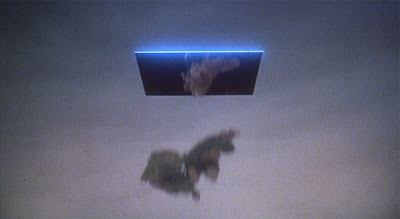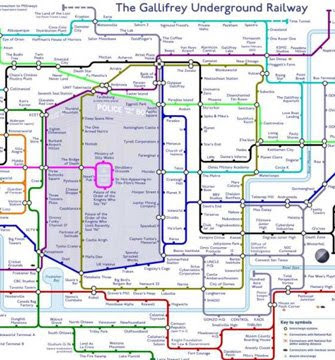Anyway, 'Time Bandits' is a popular blog topic. It is really a children's film about an English boy from 1981 called Kevin and 6 dwarfs who work for the 'Supreme Being' and have a map of flaws in the universe which allow them to jump through time and space on Earth. Portals open up for a limited amount of time, giving an urgency to their explorations as seen in this blurred image from the movie:
They are supposed to be repairing them, but use them to go round stealing treasure. The map they use is bigger than any one of them and I think some of the appeal of it, is its aesthetic. It looks as it should, cryptic and mystical, but practical too, though with potential for misinterpretation. Below are some images of the map as seen in the movie and now available to buy. The fact that people still want it 26 years later, suggests it has a pretty iconic status. Like a lot of Gilliam's work, notably 'Brazil' (1985), 'The Adventures of Baron Munchhausen' (1988), 'The Fisher King' (1991) and his abortive Don Quixote film, it is about preserving fantasy and excitement in a world obsessed with rationality, and especially in 'Time Bandits', consumerism. In Gilliam's view, it appears such ability to engage with the unreal is what keeps us free.
The map as seen in the movie:
This one was a similar map produced by the artist Jennifer Diane Reitz in the early 1980s. See: http://www.pasteldefender.com/news.html for more about her and her work, a lot of which falls into fantasy categories:
I had hoped to be able to find a Neverwhere map. 'Neverwhere' (1998) was by Neil Gaiman, the (graphic) based on a television series by him (and the comedian Lenny Henry) of the same name in 1996. It envisages a parallel world within London; London Below. All those mysterious doors you pass that no-one ever seems to open or those windowed spires on the top of Victorian buildings, actually go into this different world, inhabited both by tribes of homeless people and by fantastical creatures. All the places on the London undeground map relate to real things so an earl has a court at Earl's Court, there is a black smith at Hammersmith, there are black friars from Blackfriars (and the female vampires, the Velvets come in, as in The Velvet Underground) and there is an angel at Angel Islington and so on. I know there are lots of closed down stations on the London underground, but I suppose Gaiman's Neverwhere map would be the same as the London Underground one anyway. So I found some other unusual or faked underground railway maps, including one for the planet Gallifrey the home planet of the Doctor in the television series 'Doctor Who' (intermittently 1963- Now). The first is a map which shows the geographical rather than schematic map of the routes which usually is seen. Another one to look out for is 'The Great Bear' (1992) by Simon Patterson a conceptual map based on the traditional London Underground map outline:
The final one for now is a 'map' that seems to be all over the internet maybe influenced by the very speculative ones drawn by explorers in the 19th century, but certainly one which could provide a model for those seeking to create fantasy world maps now. Note both the inland sea and the northern mountains and wastelands:
On reflection, though, I think that this was not supposed to be satirical in the way it now seems to be portrayed, rather it was probably an aide-memoire for Victorian children to show them the generic elements of what they would find on a map. However, it would be tempting to write over the labels and use it as a fantasy world.










No comments:
Post a Comment